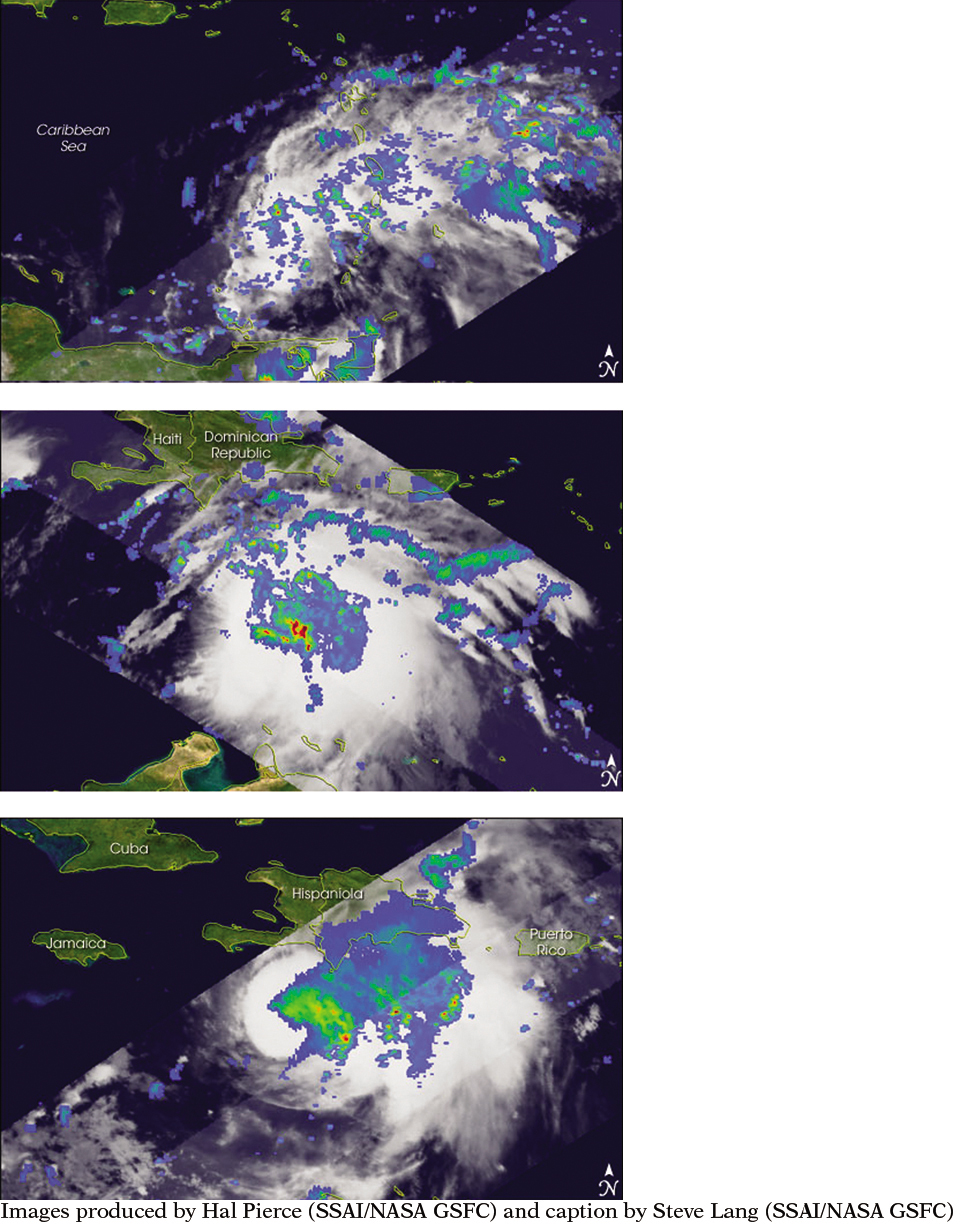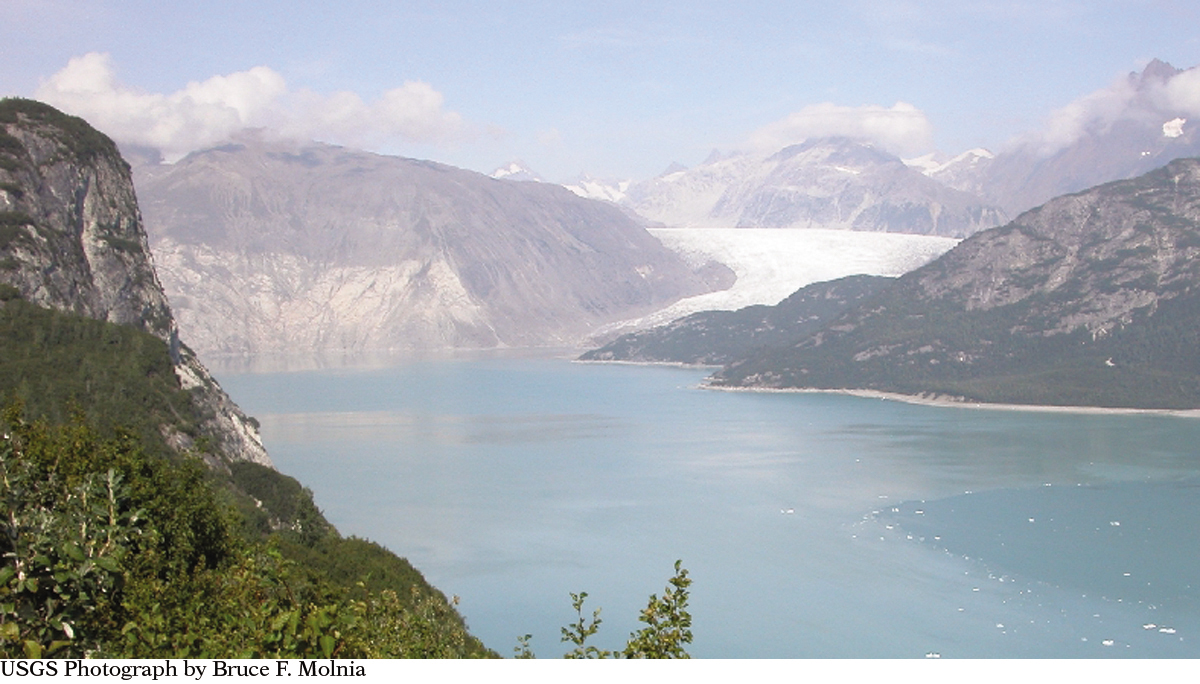LESSON 67: Hurricane!: Extreme Physical Change
343
THINK ABOUT IT
Water and air provide our planet with its weather and support plant and animal life. Weather itself is a result of a dynamic interplay of physical change between water, Earth’s atmosphere, and energy from the Sun. There are times when these physical changes create conditions that can be catastrophic. A hurricane is one example of an extreme weather phenomenon that can be quite destructive.
What are hurricanes and what causes them?
To answer this question, you will explore
The Properties of Hurricanes
Hurricane Formation
Global Warming
The Properties of Hurricanes
EXPLORING THE TOPIC
The Properties of Hurricanes

A hurricane is an enormous tropical rainstorm with powerful winds that forms over the ocean. It has a distinctive shape to it, resembling a giant rotating pinwheel. The wind speeds in a hurricane are over 75 mi/h and may even exceed 150 mi/h. The storm may bring torrential rains, destructive winds, and flooding to areas of land that it passes over. The sheer size of these storms is shown in this photo of a hurricane in the Gulf of Mexico.
These giant storms may be from 125 to 1000 mi across and 15 mi high. Further, they are characterized by very low air pressure at their centers. In general, the lower the air pressure, the larger the storm. Consider the data in the table for three hurricanes in the same year.

344
Hurricanes are categorized according to their strength, as indicated in the table. They are accompanied by a surge in coastal waters called a storm surge. A storm surge can reach 20 ft or more in height, causing major coastal flooding.
Hurricane Formation
Hurricane Formation
Hurricanes form only over very warm ocean waters of at least 80 ºF. In addition, they require a great deal of moisture in the air. For these two reasons, hurricanes originate southeast of the United States, in the tropical ocean waters near the equator.
You have probably heard people refer to “hurricane season.” Most hurricanes form during summer and fall when the waters are warmest in tropical zones. For the United States, hurricane season stretches from June through November.

A storm must grow through several stages before it is considered a hurricane. A future hurricane starts out as a tropical depression, which is a clearly defined low-pressure system with winds below 38 mi/h. Some tropical depressions continue to build and become tropical storms. In tropical storms, the air circulates around a low-pressure system with winds between 38 and 74 mi/h. Finally, a tropical storm that builds to wind speeds beyond 75 mi/h is considered a hurricane.
It can take several days for a tropical storm to develop into a hurricane. It begins with moist warm air from the ocean surface rising rapidly. The water vapor in this warm air condenses and forms storm clouds. The heat released by this condensation warms the cooler air above it, causing the air to rise even more. This process continues, with more and more warm air moving up into the developing storm. A spiral wind pattern begins to develop, and the hurricane takes on its characteristic shape. In the very center of the storm, an “eye” develops and cool air descends, creating a calm storm-free area. The eye of a hurricane may be between 12 and 60 mi in diameter. When the eye of the storm passes over an area, people will experience calm, clear conditions, as if there is no hurricane at all. The eye is surrounded by the eyewall, which is the most violent part of the storm. Near the ocean surface, spiral bands of rain stretch out for miles.
345

Global Warming
Global Warming

Earth is currently in a warming phase. Several recent hurricane seasons in the United States were unusually destructive. The number and severity of storms caused scientists to speculate that there is a connection between the increasing number and severity of hurricanes and the warming of the entire planet. In other words, Earth may be undergoing long-term climate change.
Experts think that the warming of the planet is worsened by our practice of using petroleum products for our energy needs. Burning gasoline, coal, and natural gas releases enormous amounts of carbon dioxide into our atmosphere. Increases in carbon dioxide have jumped up rapidly in recent years. This increase causes a greater amount of heat to be trapped in the Earth’s atmosphere and is linked to an increase in average air temperature.

Field, W. O. 1941. Muir Glacier. From the Glacier Photograph Collection. Boulder, Colorado USA: National Snow and Ice Data Center/World Data Center for Glaciology. Digital media. (Left)
|

USGS Photograph by Bruce F. Molnia
|
GEOLOGY CONNECTION
GEOLOGY
CONNECTION
This drawing is a depiction of the projected new coastline of the eastern United States if the polar ice caps melt completely to water.

346
Meteorologists hypothesize that increases in ocean temperatures of only a few degrees may have dramatic effects on the weather of our planet, including the possibility of increased frequency and intensity of hurricanes. One degree may not sound like much, but it is sufficient to raise ocean levels by a few inches and to cause more rainfall and stronger storms.
Studies show a steady increase in global temperature over the past 120 years. Scientists hope energy conservation will help to reverse or slow down this warming trend. Automobile makers are actively involved in creating vehicles that run on alternative energy sources.
LESSON SUMMARY
LESSON SUMMARY
What are hurricanes and what causes them?
A hurricane is a large and powerful tropical storm with intense spiraling winds. Hurricanes form over the warm tropical waters near the equator. At the very center of a hurricane is an area of extremely low air pressure. The heat released when moist warm air rises and condenses into storm clouds powers hurricane formation. Also, the low pressure caused by condensation draws more air into the storm from areas of relatively higher pressure. This cycle of evaporation and condensation of very large amounts of water is a key feature of hurricanes. Experts studying climate changes due to global warming are monitoring data about increases in the frequency and intensity of hurricanes.
Exercises
Reading Questions
What conditions are necessary for hurricane formation?
Write a creative paragraph describing what life on the planet may be like if global warming continues at its present pace.
Reason and Apply
Find data showing that ocean temperature is related to the wind speed of a hurricane. Discuss three pieces of evidence that global warming is occurring.